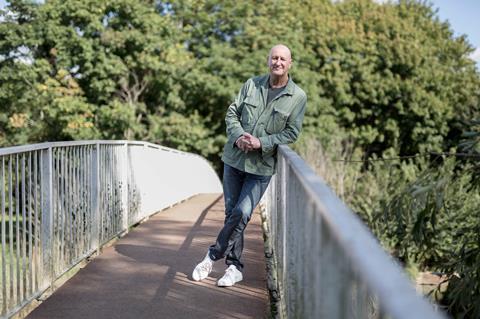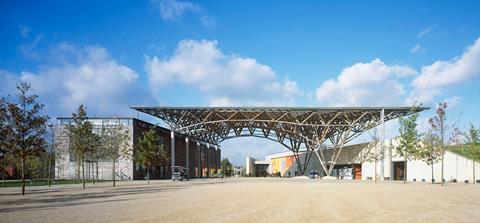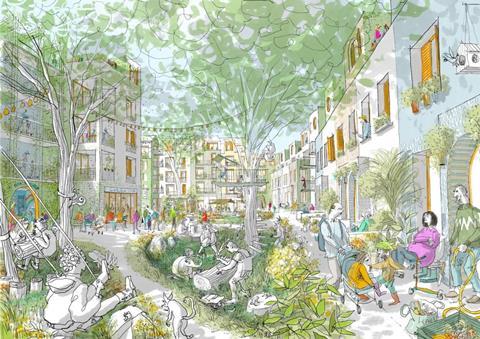From running Greenpeace to not buying Bankside power station, the developer behind Lewes’s Phoenix project doesn’t follow the herd, writes Ben Flatman

If there’s an archetypal property developer then Jonathan Smales probably doesn’t fit the mould. A former managing director of Greenpeace, who oversaw the organisation’s rapid growth in size and influence during the 1980s, he was then CEO of the Earth Centre in Doncaster for a decade, before setting up a consultancy to advise on sustainable regeneration and housing.
He’s now in the headlines again as the CEO and co-founder of Human Nature, the company behind Phoenix, a 685-home sustainable neighbourhood in Lewes, that won planning this week. The transition into property development has come after years of frustration with seeing the schemes he was working on stripped of their green credentials through cost cutting.
Smales grew up just south of Leeds in the coal field communities. This world had a major impact on him: “I just had this sense that there must be another world out there.” He remarks on the despoliation of the mining landscape and the “harsh life experiences” for everyone around him growing up. “I think that gave me a yearning for making a better place. And also a fantastic insight to what a resilient community is like - because that’s what they were.”
Human Nature, the company Smales has established to deliver his singular vision for a new mixed-use development - first in Lewes and then in a line of sites elsewhere in the UK, is all about showing the industry that it can build densely, sustainably, and perhaps even beautifully, even in the most challenging of contexts.
Underlying the vision is a belief in community. He sees the UK as being in a challenging place, with its social as well economic fabric fraying. The Phoenix aims to address a myriad of problems by providing a sustainable economic model and showing that there are better ways to build and live.
“I love the tangibility of building, working with designers. I like the fact it’s got a beginning, a middle and an end”
At university in Newcastle he studied urban geography, reading Rachel Carson and Jane Jacobs. “It changed my life really reading their work,” says Smales. After a few years in the civil service he spotted an advert for managing director at Greenpeace and got the job.
Rapid growth meant the organisation was constantly moving premises. Smales found this frustrating and inefficient. “What dawned on us was how we could use a building project to shift the culture of the organisation. The model I wanted for Greenpeace was one in which the campaigners collaborated with one another,” he says.
“No one had ever done a green commercial office in the UK. They just didn’t exist. We sat there in a room looking at each other wondering ‘well, who’s got the answer to this’. We had to work out what it meant,” says Smales. “I appointed two architecture students from the Bartlett to cycle around north London for six months looking for sites. I wish I’d bought all the buildings that they found!”
> Also read: Former Greenpeace directors win planning for UK’s largest timber neighbourhood
Greenpeace ended up buying a former animal testing lab in Canonbury, and appointed a team that included Neil Thomas of Atelier One, Patrick Bellew and architects Feilden Clegg. “It was just a really lovely project to do. I really loved it. It was great karma for a building that had been an animal testing laboratory to become Greenpeace HQ”.
Looking back at the project Smales observes: “I love the tangibility of building, working with designers. I like the fact it’s got a beginning, a middle and an end. You finish something. It was a pleasure for all of us. I think the secret was to find a very good professional team with the right sensibility and then to give them what they needed to do their job.”
He left Greenpeace in 1991: “I decided to take some time off to be a modern dad. I just wanted a bit of breathing space.” At the time he was living next door to John Letts, a founder of the European Museum of the Year Award, who asked Smales why there wasn’t a museum focused on sustainability and the environment.

It was in the run up to the Rio Earth Summit in 1992, at a time when Margaret Thatcher was a powerful advocate for action on climate change. Smales notes that the environment was a bigger issue in the media at the time than perhaps it is even today. “It really felt like the world was shifting on its axis – a paradigm change”.
Letts’s question got Smales thinking and he ended up spending the next decade on the development and implementation of the Earth Centre in Doncaster. Smales references “Prince Albert’s vision” for the V&A, Science Museum and Natural History museum in South Kensington. “Put them together and update them by 200 years and then you’re talking about sustainability”.
Although the project closed in 2004, it provided Smales with a steep learning curve on developing a complex site. “We worked with Feilden Clegg and a few others. We looked at Bankside Power Station as a possible site for it, which I should have said yes to of course, but I didn’t want it to be just an urban project.

“I wanted it to be regenerative - to have a landscape and place where people could see nature recovering as well and demonstrate different types of habitats.” Looking back Smales says “I was foolish not to have followed through [on Bankside] because with a project of that prestige you really want to be in central London.”
Smales believes one his biggest lessons was in procurement and how to “achieve excellent design without breaking the bank.” Talking about the project in Lewes, he says “It’s one of the things we really major on here. There’s a lot of innovation and you can’t afford to be casual on budget control. It’s actually the opposite.”
After departing from the Earth Centre, Smales moved into consulting. “Sustainability was just starting to happen in the development world,” he notes. And around the end of 2000 he created a company called Beyond Green. “I didn’t really have a plan actually. I was just being asked to do projects for people. I wasn’t interested in being a consultant. But a couple of years in I had 35 people and a consulting company.”
One of their first projects was a campaign to promote the public understanding of climate change, followed by a sustainable development strategy for the Housing Corporation in 2001-03 - “a massive consulting project” says Smales. “We interviewed all the big developers asking what did sustainability mean to them. Later they started asking us to do projects for them as they were asking us ‘what does it mean?’”
This led to Beyond Green being introduced to the BP pension fund, something which Smales with his Greenpeace background says “was a bit ironic”. BP owned a thousand acres just north of Harlow that had been earmarked for a new town. “With the Prince’s Foundation we came up with a vision to connect to Harlow and complete the unfinished new town, but to do it in a much denser, I suppose New Urbanist way.”

“That was a gamechanging foray into sustainable communities. It was ‘out there’ sustainable. The design was much denser, even than the ones today,” says Smales. The project envisaged 25,000 homes. Smales was disappointed when the BP pension fund sold up, setting back the scheme’s delivery by several years. But it was bought by Places for People, which is now implementing the development with Taylor Wimpey as Gilston Villages, with around 10,000 thousand homes. And Places for People’s ex CEO, David Cowans, is now chairman of Human Nature.
“I made a mental note that I didn’t enjoy consulting any more, but it kept on coming”, says Smales. Beyond Green’s next big project was the 2012 London Olympics, which included the Olympic Park and then the legacy, which Smales worked on for seven years.
Smales clearly found the consulting role increasingly frustrating, as he saw developers often unable to deliver on their sustainability goals. “It wasn’t dull but you get to that stage with a new project where the CEO of a big development project looks you in the eyes and says ‘I want this to be the greenest new settlement in Europe’.
“And there was real sincerity there. What there wasn’t was the organisational capacity to deliver. And so at that point I was hatching the plans to ease out of consulting and create Human Nature”.

Changing the way in which people live is core to the Lewes development. Smales references SPACE10, IKEA’s research lab (his wife worked for IKEA for several years). He describes SPACE10’s research into shared living as “a big inspiration for us”.
“Of course it’s very Scandi”, says Smales, enthusing about the shared living ethos. “You don’t just share storage and a bike shed, you share a courtyard garden and maybe a common room, a launderette, maybe you share your utility bills and you bulk buy food and insurance. And when you start to do that, the economies are actually incredible. So that’s something we’re looking at for the future here.”
“Environmentalists often sound very preachy, but it never works” says Smales. “What works is collective action, whether it’s diet, exercise or carbon” he adds, before explaining how the Phoenix hopes to use “peer group context” to promote walking, cycling and generally healthier ways of living.
“The biggest commercial aspects of it is this big tectonic shift that’s happening in the world”, he says. “There’s no one - whatever kind of investor or developer that you are - that can be removed from it.
“The way that the investment community is moving, particularly the bigger investors - they’re actually giving themselves some very serious policies in ESG, in other words environmental and social governance. And at a certain point they’re going to have to say where are the businesses, where are the projects that can fulfil these different objectives.”
He believes some in the industry are pushing back on the sustainability agenda, but doesn’t believe that will last. “At the moment some of the industry is resistant to change. I don’t know about the housing targets, but in terms of the environment you better get ready for a lot more frankly because we’re not even touching embodied carbon yet.”

Smales sees Human Nature as making a difference at the neighbourhood level. “So there’s this paradigm shift that’s happening in the world of investment. The UN secretary general said there is no credible pathway to 1.5 degrees so we obviously have to speed up in every space and we think placemaking at the neighbourhood scale is a way you can make it relatable to ordinary people.”
Human Nature sets ambitious targets on carbon, aiming for 2.3 tonnes of carbon per person across their projects - what Oxfam calls global “Fair Shares” carbon. “If you’ve got 8 billion people on the planet, times that by 2.3 tonnes - that’s how much carbon the world can emit to stay within 1.5 degrees warming”, says Smales, comparing it to the 11.5 tonnes per person as the current UK average.
Human Nature is already looking at other sites for further projects. He wants to see a “real groundswell from projects like this” that enables “people to see that a sustainable future can make for a better economy, a better place to live.” He believes the Phoenix will deliver a “better quality of life and actually even a cheaper way of living”. It would be, as he says, “a fantastic set of wins”.
















No comments yet